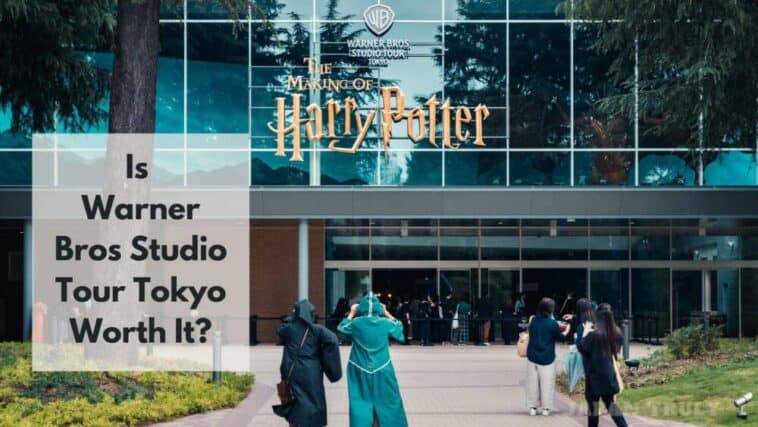Is Edo-Tokyo Museum worth it? The Edo-Tokyo Museum is a must-visit for anyone interested in the history of Tokyo and Japan. With its immersive exhibits, life-size dioramas, and interactive displays, the museum brings the past to life in a truly engaging way.
Visiting the Edo-Tokyo Museum is often at the top of the to-do list for travelers in Japan. Located in the Ryogoku district of Tokyo, the museum offers a glimpse into Japan’s rich past, specifically the Edo period (1603-1868).
As a cultural enthusiast, I have visited several museums, and I’m excited to share my perspective on whether spending your time and money at the Edo-Tokyo Museum is worth it.
Upon entering the museum, I was immediately captivated by the building’s architecture and exhibits. The museum itself is a work of art, reminiscent of an ancient Japanese palace.

Once inside, I found that the museum houses a plethora of artifacts, models, and multimedia exhibits, all aimed at educating visitors about the Edo period’s culture, art, and day-to-day life. The attention to detail and historical accuracy in each exhibit was impressive.
Another factor to consider when determining the worth of visiting the Edo-Tokyo Museum is its affordability.
Compared to other attractions in Tokyo, I found the museum’s admission fees quite reasonable, especially considering the wealth of information and experiences available.
Additionally, English-speaking guides and informational pamphlets provided by the museum make it accessible to a wide range of visitors.
Page Contents
Is Edo-Tokyo Museum Worth It?
the Edo-Tokyo Museum is absolutely worth a visit. It offers a captivating journey through the rich history of Tokyo, from its humble Edo beginnings to its modern-day transformation. The interactive exhibits and meticulously recreated Edo-era streets immerse you in the city’s past, making history come alive.
The museum’s innovative use of technology, including impressive dioramas and multimedia displays, enhances the experience.
Whether you’re a history buff or just curious about Tokyo’s evolution, the Edo-Tokyo Museum provides a fascinating insight into the city’s vibrant heritage. I left with a deeper appreciation for Tokyo’s history and culture, making it a must-see attraction.
Background of Edo-Tokyo Museum
When I first visited Japan, I knew I had to experience the rich history of this fascinating country. That’s when I came across the Edo-Tokyo Museum. It’s a museum dedicated to preserving the history of Tokyo, specifically during the Edo period and throughout the 20th century.
This museum aims to educate visitors about the cultural and historical aspects of the Japanese capital, spanning from the early days of the Tokugawa shogunate to the present day.
The Edo-Tokyo Museum was established in 1993 and is located within the Tokyo Metropolitan Edo-Tokyo Museum complex. Its impressive architectural design, by Kiyonori Kikutake, is a symbol of Japan’s continuous evolution and growth.
The main exhibition hall has stunning replicas of key structures from different time periods, offering visitors an immersive experience into Tokyo’s historical landscape.
In the 17th century, the Edo period began when Tokugawa Ieyasu established his shogunate in what is now modern-day Tokyo. The city flourished under his rule, becoming a hub of art, culture, and commerce.
The Edo-Tokyo museum showcases the vibrant life of people during this time, with artifacts, dioramas, and interactive exhibits that vividly bring the city’s history to life.
It’s fascinating to see the complex political and social hierarchies that governed Edo and how they contributed to its prosperity.
The museum also explores the significant role of the Meiji Restoration in Tokyo’s development. This period marked the end of the Tokugawa shogunate and the beginning of Japan’s modernization under Emperor Meiji.
The exhibits display the rapid changes in Japan’s society, politics, and technology during the late 19th and early 20th centuries. As I walked through the museum, the influence of Westernization on Japanese culture became apparent, resulting in a unique blend of traditional and modern aspects.
One aspect of Tokyo’s history that the museum highlights is the Great Kanto Earthquake of 1923. Destroying vast areas of the city, this natural disaster tested the resilience of Tokyo and its inhabitants.
The museum captures the aftermath and the efforts in reconstruction, providing a glimpse of the city’s determination to recover and rebuild.
As a lover of history, the Edo-Tokyo Museum provided me with a deep understanding of the Japanese capital’s rich and diverse history. Through well-curated exhibits, the museum is a must-visit for those eager to explore the history of this vibrant and dynamic city.
- Related: Is Tokyo Sea Life Park Worth It?
Location and Accessibility Of Edo-Tokyo Museum
I recently visited the Edo-Tokyo Museum, and I must say that its location and accessibility are quite impressive. The museum is situated in the heart of Tokyo, specifically in the Ryogoku district. This area is well-known for its historical significance and vibrant atmosphere.
To reach the museum, I took a train to the Ryogoku Station. The museum is just a short walk from the station, making it convenient for tourists and locals alike.
As I walked to the museum, I noticed that the surrounding neighborhood was bustling with activity. There are several popular spots nearby, such as the Nihonbashi and Asakusa districts.
Asakusa is particularly famous for the Sensoji Temple, which I highly recommend visiting before or after exploring the Edo-Tokyo Museum.
The temple is a magnificent example of traditional Japanese architecture and Buddhism, providing an excellent contrast and complement to the modern and historical exhibits showcased at the museum.
The museum itself is wheelchair accessible, ensuring that all visitors can conveniently experience the exhibits.
Furthermore, the staff is friendly and well-versed in multiple languages, so I had no trouble navigating the museum and learning more about the history of Edo-Tokyo.
In summary, the Edo-Tokyo Museum’s location in the culturally rich Ryogoku district, combined with its proximity to popular tourist destinations like Nihonbashi and Asakusa, makes it easily accessible and worth exploring for anyone interested in learning more about Tokyo’s history and culture.
Architectural Overview Of Edo-Tokyo Museum
The Edo-Tokyo Museum showcases the architectural marvels of the historical periods of Japan. I was particularly impressed by the various city models depicting the evolution of Tokyo from the Edo period to the present day.
These intricate city models offer a glimpse into the urban development of the past, allowing visitors to appreciate the transformation of the city over the centuries.
One of the highlights of the museum is the life-sized replica of the Nihonbashi Bridge, an iconic symbol of the Edo period.
Standing on the wooden bridge, I could imagine being transported back in time to experience the bustling atmosphere of ancient Tokyo. The replica also offers a valuable insight into the traditional Japanese architectural techniques employed during that era.
Besides the Nihonbashi Bridge, I found the architectural models of famous buildings in Nagoya quite intriguing. These models are meticulously crafted to display the unique structural designs and traditional elements, providing a comprehensive understanding of the Japanese architectural heritage.
Observing these models closely, I could also notice the distinctive features of the different periods, reflecting Japan’s cultural diversity and historical depth.
In summary, the Edo-Tokyo Museum is a captivating destination for architecture enthusiasts, as it provides a visually engaging and informative journey into Japan’s architectural history. From city models to the Nihonbashi Bridge, the museum offers a wealth of knowledge to visitors, all in a neutral, clear, and confident manner.
Collection and Exhibitions At Edo-Tokyo Museum
At the Edo-Tokyo Museum, I was fascinated by the remarkable collection and exhibitions that it houses. The permanent exhibition focuses on the history, culture, and lifestyle of Edo (now Tokyo) from the 17th to the 20th century.
Spread out across the floors of the museum are numerous exhibits that showcase original objects, replicas, interactive displays, and artifacts.
The special exhibitions at the museum are engaging and worth attending. They display Japan’s national exhibits related to history and art, including works by Katsushika Hokusai, a famous ukiyo-e painter known for his woodblock prints and intricate miniatures.
In addition to the special exhibitions, the museum has an extensive gallery about Kabuki theater and its history.
From the historical items and old artifacts on display, I gained a deeper understanding of what life was like during the Edo period. The museum features miniatures, maps, and detailed reproductions of houses that show how Edo citizens lived.
Around the exhibition halls, I even had the opportunity to interact with some displays, making the experience not only informative but also engaging.
The museum shop and gift shop add to the experience by offering a range of beautiful souvenirs and collections inspired by the exhibits I saw. From art books to ornamental pieces, these shops have plenty of options for people looking to bring home a piece of history from their visit.
Lastly, the museum’s library provides an excellent resource for further study and learning about Edo and its culture. With a wide variety of books and reference materials, I found it to be a treasure trove for scholars and enthusiasts alike.
In summary, the Edo-Tokyo Museum is a must-visit for anyone interested in Japanese history, culture, and art. The collection and exhibitions are informative, visually engaging, and immersive, making the entire experience unforgettable.
- Related: Is teamLab Tokyo Worth It?
Experience A Journey Through History
As I stepped into the Edo-Tokyo Museum, I was immediately transported back in time to the Edo period, a significant era in Japan’s history that lasted from 1603 to 1868. The museum offers a unique opportunity to immerse oneself in the rich history of the feudal city, which later transformed into a bustling metropolis.
Walking through the vividly reconstructed street scenes, I gained an appreciation for the daily life of various social classes, including the samurai.
Within these life-size displays, one could see the Edo Castle, a magnificent landmark from the past. The streets were lined with various shops that showcased historical paintings, pottery, and scripts from that era.
The museum not only covers the Edo period but also delves into the subsequent changes that occurred in Japan. These include the famous Meiji Restoration, the Showa period, and the terrible devastation caused by the Great Kanto Earthquake.
Each of these historical eras is comprehensively presented through informative exhibits and engaging displays.
A particular highlight for me was the vast collection of interactive activities, such as the chance to participate in ancient games and experience traditional crafts.
This made the visit even more exciting and educational, as I was able to directly engage with Japan’s ancient history and culture.
In conclusion, the Edo-Tokyo Museum provides an incredible journey through history, offering a fascinating glimpse into the evolution of Japan’s capital city, from its roots as a medieval city up to its present-day status as a thriving metropolis.
I believe it is unquestionably a must-visit tourist attraction for anyone interested in Japanese history and culture.
Interactive Education At Edo-Tokyo Museum
During my visit to the Edo-Tokyo Museum, I found its interactive educational offerings to be one of the standout features. With a variety of life-sized exhibits, workshops, and interactive spaces, the museum caters to not only history buffs but also children and families looking for an engaging and educational experience.
In the interactive space, I found a wide range of displays that bring to life the various aspects of Edo and Tokyo’s history. Children can touch and explore the life-sized exhibits su-60fe-63ch as traditional Japanese tea houses, merchant shops, and houses.
This hands-on approach offers a unique way for kids to learn about the past and truly immerse themselves in the experience.
Alongside these life-sized displays, the museum holds regular workshops that cover various themes and topics related to Edo and Tokyo’s culture and history.
During my visit, I had the chance to participate in a traditional Japanese calligraphy workshop, which allowed me to understand the art form better and appreciate its deeply rooted significance in the region’s history.
To further enhance the learning experience and cater to a diverse range of visitors, the Edo-Tokyo Museum offers additional interactive materials, such as audio guides, touch-screen displays, and informative videos.
These resources proved to be beneficial and engaging for me as they provided clear explanations and vivid illustrations of various aspects of Edo and Tokyo’s past.
In all, the interactive educational experiences at the Edo-Tokyo Museum make it a worthwhile destination for anyone interested in Japanese history and culture. The museum goes above and beyond to create an engaging, immersive experience for visitors of all ages and backgrounds.
Visitor Experience At Edo-Tokyo Museum
Upon entering the Edo-Tokyo Museum, I was warmly greeted by the staff at the reception area, and I opted for a personal tour by one of their knowledgeable volunteer guides.
The guide, who was an English-speaking local, explained the history and significance of each exhibit, enhancing my appreciation of the museum’s extensive collection.
My journey began at the lower level, where meticulously crafted life-size replicas of structures from the Edo period are showcased, allowing me to feel as if I had stepped back in time.
Examining the various commodities that would have been used during that era, such as ancient clothing items, provided insight into the daily lifestyle of people living in Edo (now Tokyo).
Furthermore, the museum offered exhibits that showcased the evolution of Tokyo throughout various eras.
The displays at the museum are designed for an immersive experience. For instance, sections of the museum demonstrate daily life in the city, including models of houses and shops where visitors can interact with the exhibits, giving a more tangible understanding of the past.
The museum’s dedication to historical accuracy helped me appreciate the authenticity of my experience.
Throughout my visit, I appreciated the attentiveness of the staff and the helpful guidance provided by the tour guide.
Their passion for sharing knowledge about the rich history of Tokyo was evident, and it only enhanced the captivating ambiance of the museum.
In conclusion, my experience at the Edo-Tokyo Museum was truly remarkable. The combination of engaging exhibits and the support of the passionate staff allowed me to explore and appreciate Tokyo’s history like never before.
I am confident that anyone with an interest in Japanese culture and history would find their visit to the Edo-Tokyo Museum to be a rewarding and unforgettable experience.
Cultural Insights At Edo-Tokyo Museum
When I visited the Edo-Tokyo Museum, I discovered an incredible range of Cultural Insights that provided a rich experience and understanding of Japan’s history and culture. As I entered the museum, I was immediately struck by the life-size replica of the Nihonbashi Bridge, one of the most famous bridges in Japan. The museum thoroughly transported me through time, allowing me to immerse myself in the traditional homes, rickshaws, and living quarters that really captured the essence of Japan’s past.
The Edo-Tokyo Museum opened my eyes to the world of samurais, as it showcased their armor, weapons, and lifestyles. I was impressed by the intricate woodblock prints that depicted various aspects of Japanese life, from pleasure districts to sumo wrestling.
I also learned about the Sumo wrestling complex and its cultural significance which was very intriguing.
Visiting the museum, I gained a deeper understanding of Japan’s cultural heritage in terms of traditional homes and living quarters. The architectural displays were incredibly detailed, including the subtle changes in design throughout Japan’s history.
I was particularly fascinated by the beautifully crafted rickshaws, as they provided a glimpse into the daily life and transportation of people in the past.
As I explored deeper into the museum, I was amazed to find a family computer on exhibit, demonstrating Japan’s impact on the global technology scene. Through its evolution from the Edo period towards modern Tokyo, the fusion of traditional and modern elements made for an enriching experience.
Lastly, the Kabuki theatre exhibit transported me to the world of traditional Japanese performing arts, where I witnessed the lavish costumes, makeup, and stagecraft that are integral parts of this enthralling culture. The museum’s portrayal of the ancient pleasure districts and their connection to Kabuki theatre was thought-provoking and enlightening.
Services and Facilities Available At Edo-Tokyo Museum
I found that the Edo-Tokyo Museum offers a variety of services and facilities worth mentioning. Firstly, the museum shop caught my attention, presenting an extensive range of items, from Japanese art and crafts to books and replica models of old Edo-Tokyo. The shop is conveniently located on the lower level of the museum.
Additionally, there is a separate gift shop on the same level offering a range of souvenirs, such as traditional Japanese toys, paper crafts, and other unique mementos, allowing visitors to take home a small piece of Japanese culture.
During my visit, I noticed that the museum provides volunteer guides who are ready to assist and make the experience more enjoyable.
These guides offer tours in various languages and share their knowledge of Edo-Tokyo history, helping visitors dive deeper into understanding the exhibits and gaining insight into the rich culture.
To sum it up, the Edo-Tokyo Museum offers a well-rounded experience with a range of services and facilities that cater to visitors’ needs. The museum shop, gift shop, and volunteer guides contribute positively to the overall experience, making it a visit worth considering.
Food and Souvenirs At Edo-Tokyo Museum
During my visit to the Edo-Tokyo Museum, I had the opportunity to explore their museum shop, which offers a variety of souvenirs and gift items. The shop has an array of keepsakes, ranging from traditional crafts to more modern, Tokyo-inspired items.
There’s something for every taste and budget, which makes it a great place to find unique gifts for friends and family.
I also noticed that the museum features a food section, where visitors can indulge in scrumptious Edo-style cuisines. One of the highlights was the udon noodles, which were perfectly cooked and served in a delicious broth.
I also had the chance to try some of the available bento-boxes, which were not only visually appealing but also very tasty. These portable meals are ideal for busy tourists who want to make the most of their time at the museum.
The quality and presentation of the food here impressed me, and I found the prices to be quite reasonable.
The Edo-Tokyo Museum clearly puts effort into providing an excellent dining experience for its visitors, which adds to the overall enjoyment of the museum experience. Furthermore, the staff was friendly and attentive, ensuring that I felt welcomed and comfortable during my visit.
In conclusion, the food and souvenir options at the Edo-Tokyo Museum are definitely worth exploring. From the well-curated gift shop to the delectable dining options, I found this aspect of the museum to be a wonderful addition to my experience.
Conclusion
I visited the Edo-Tokyo Museum in Tokyo, Japan and found it to be a worthwhile experience. The museum is an impressive landmark and a popular tourist attraction, which showcases the history and culture of Edo-period through present-day Tokyo.
The museum’s design and exhibits were engaging, providing me with a clear and accessible understanding of the city’s transformation over the years. The displayed artifacts, models, and interactive exhibits were informative, bringing to life the everyday experiences of Edo-Tokyo’s inhabitants.
As I explored the museum, I appreciated how it was an all-encompassing experience, delving into various aspects of Tokyo’s history, including politics, society, culture, and economics. This comprehensive approach made my visit both educational and enjoyable.
In terms of practicality, I found the museum to be accessible, easy to navigate, and reasonably priced, which enhanced my overall experience. Additionally, the availability of English-speaking guides and informative brochures ensured that the exhibits catered to a diverse range of visitors.
Based on my experience, the Edo-Tokyo Museum holds great value for both tourists and locals alike. It offers a solid introduction to Tokyo’s rich history and is a must-visit destination for anyone looking to gain a deeper understanding of this iconic city.
Edo-Tokyo Museum: FAQs
How does Edo-Tokyo Museum compare to Tokyo National Museum?
In my opinion, both museums offer unique experiences and cater to different interests. The Edo-Tokyo Museum primarily focuses on the history and culture of the Edo period (1603-1868) and Tokyo’s development.
On the other hand, the Tokyo National Museum covers a broader scope, showcasing Japanese and Asian art, history, and archaeology. If you are particularly interested in the Edo period, you might find the Edo-Tokyo Museum more appealing.
What can I expect to see at the Edo-Tokyo Museum?
At the Edo-Tokyo Museum, you can expect to see exhibits that depict the life, culture, and architecture of Edo-Tokyo. Life-size reconstructions of buildings, streets, and shops help visitors immerse themselves in the historical atmosphere.
Additionally, there are interactive displays and models, making the experience engaging and informative.
You can also find exhibits focused on the Great Kanto Earthquake, World War II, and the post-war reconstruction of Tokyo.
Are there special exhibits at the Edo-Tokyo Museum in 2023?
Yes, the Edo-Tokyo Museum typically hosts multiple special exhibitions throughout the year. Check their official website for the latest information on current and upcoming exhibits in 2023 to plan your visit accordingly.
How much time should I allocate for a visit to Edo-Tokyo Museum?
I would recommend allocating at least 2 to 3 hours for a visit to the Edo-Tokyo Museum. This should allow ample time to explore the main exhibits, and possibly a special exhibition if available. If you plan to attend any events or workshops, you may want to allocate additional time.
Is Edo-Tokyo Museum suitable for children and families?
Yes, the Edo-Tokyo Museum is suitable for children and families. The interactive exhibits and life-sized displays can be engaging and informative for visitors of all ages. The museum also occasionally hosts workshops and events specifically designed for families and children.
What are other highly recommended museums in Tokyo?
Tokyo is home to numerous world-class museums. Some other highly recommended museums include the Tokyo National Museum, the Mori Art Museum, the National Museum of Modern Art, the Nezu Museum, and the Ghibli Museum.
The choice of museum depends on your interests, as each museum focuses on different aspects of art, history, or culture.
My writing focuses on the various aspects of Japanese lifestyle, from traditional tea ceremonies and flower arrangement to modern fashion trends and pop culture. Through my articles, I aim to share my passion for Japan and provide readers with a glimpse into the rich and diverse world of Japanese culture.
I believe that the key to understanding Japanese lifestyle is to appreciate the balance between tradition and innovation. While Japan has a rich cultural heritage that dates back centuries, it is also a country that is constantly evolving and embracing new ideas and technologies.
Whether you’re interested in learning about the latest fashion trends in Tokyo, or want to explore the ancient art of calligraphy, my writing will take you on a journey through the many facets of Japanese lifestyle. So join me as we explore the beauty and complexity of this fascinating culture together!





